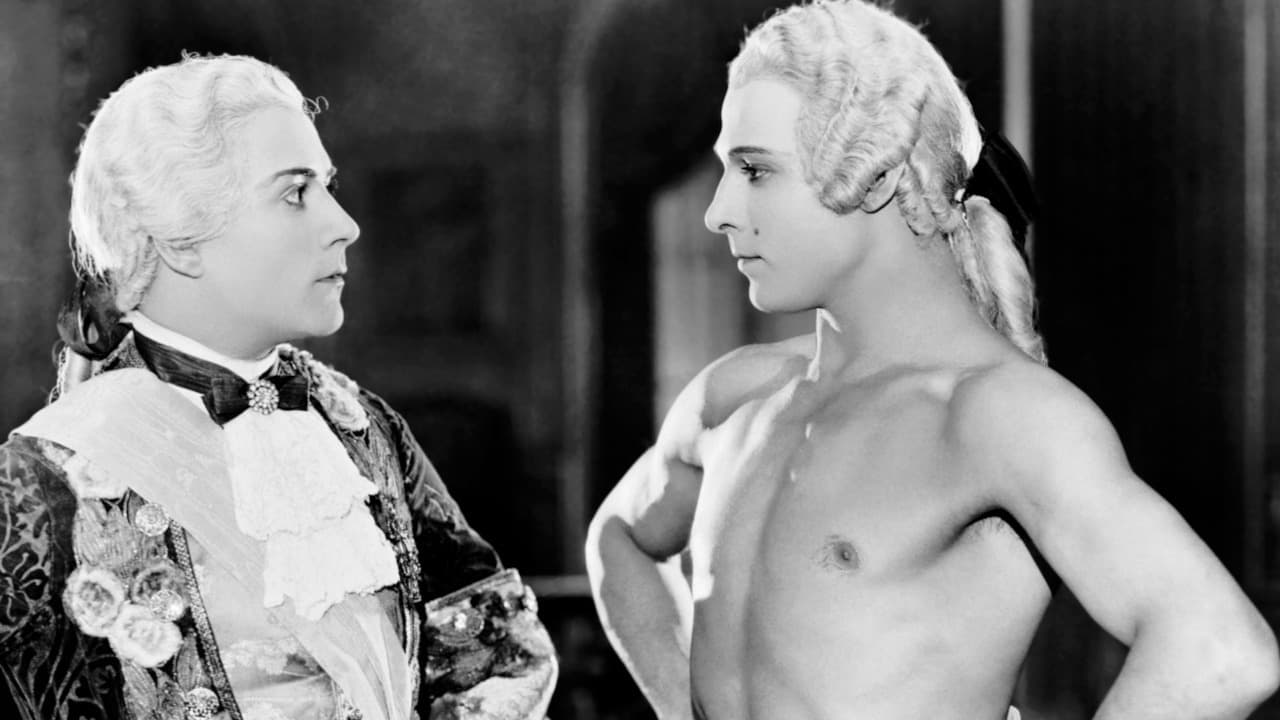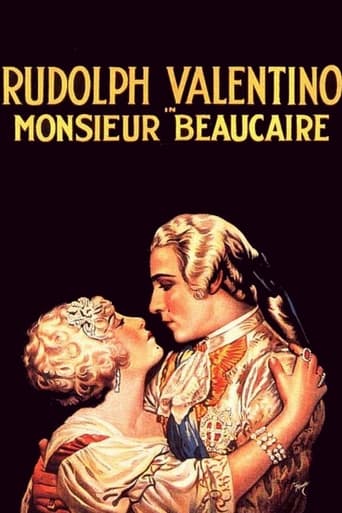

Olcott is obviously a director of the old chain-the-camera-to-the-floor-and-use-an-iris-mask-on-the-lens school. His fondness for the mask not only robs us of the first sword-fight, but often seems both distracting and out of place. As if these problems were not enough for the picture to shoulder, they have been compounded 300% by the extremely eccentric way the film has been re-edited from 10 reels to 7. For the first two-thirds of its present length, Monsieur Beaucaire is not a movie at all, but a parade - a seemingly endless parade of characters who are elaborately introduced via verbose inter-titles, take their self-important bows, and then disappear forever. When we finally reach the Bath episodes and the story actually develops a smidgin of a plot and all six or seven hundred of the people not directly involved have departed the stage, the action actually becomes quite exciting. Maclaren and Shannon make a fine pair of villains, Doris Kenyon is great as the beauty with a heart of ice, and Rudy himself proves to be no mean swordsman.Of course, by this time, most people have given up on the movie and are watching something else. Me, too! But being a thrifty Scot, I decided to take another look. I almost gave up again, but I was fascinated. I thought, when is this parade of overly verbose and utterly useless inter-titles ever going to stop? Answer: Bath, about 80 minutes in, leaving 34 minutes of exciting action. And would you believe, at this happy point the quality of the print improves enormously as well? It actually comes into nice sharp focus and you can actually see Rudy holding his own against a whole army of ruffians. Wonderful!
... View MoreRudolph Valentino (as Philippe, aka the "Duke de Chartres") is a member of France's 18th century powder set; he and royal cousin Bebe Daniels (as Princess Henriette) are quite a pair, but etiquette gets in the way. So, Mr. Valentino leaves the court of Lowell Sherman (as King Louis XV) and Lois Wilson (as Queen Marie); and, he relocates to Bath, England. There, he assumes the identity of ordinary barber "Monsieur Beaucaire". Valentino enjoys life as a commoner; nonetheless, he quickly assumes the role of a French nobleman, in order to romance Doris Kenyon (as Lady Mary). Eventually, he realizes there's no place like home After a two year strike, Rudolph Valentino made "Monsieur Beaucaire" his comeback film. It's an elaborate, confusing, and mannered production. Nevertheless, in Valentino's case, absence did make the hearts of America grow fonder; and, Valentino spent the next two years as the USA's top male Box Office Star. Probably, the position was enhanced due to the continued circulation of the star's previous hits."Monsieur Beaucaire" is a valiant failure. Staid, light and shadow direction by Sidney Olcott, daintily made-up and costumed players, and elaborately designed scenes are featured. The story of a royal assuming the commoner's role is interesting; but, despite the title, Valentino is only briefly seen in the entertaining role of barber. Possibly, the film's focus was lost during the making.One of Valentino's 1923 song recordings was added to the soundtrack; listen for it when the star sings a serenade, near the film's beginning. A record wasn't released until later, but the song is chronologically correct, herein; thematically, the Valentino recordings more closely fit other films, however. This recording, and Valentino's successful American tour, suggested a Garbo-like success in talking films was possible, had Valentino lived into the sound era. ***** Monsieur Beaucaire (8/11/24) Sidney Olcott ~ Rudolph Valentino, Bebe Daniels, Lois Wilson
... View MoreThis survives in a crisp, sharp, a very beautiful print in the Library of Congress. The overriding problem with this film is it's director: SIDNEY OLCOTT. Olcott's direction is of the old DW Griffith school of film making. A method of directing by Olcott as can be evidenced in his Marion Davies picture of the previous year, LITTLE OLD NEW YORK. In both 'Beaucaire & 'New York Olcott frustratingly plants his camera for the habitual mid-shots & long-shots and occasional closeup as Griffith had done since before WW1 and was currently still doing. This is fine when doing historical or costume pictures like these to showcase the sets, costumes, hairstyles etc where big money had been spent. But to get us through the story the camera should be a little more fluid, move with the actors through the scenes, involve the audience in the subjective instead of constantly relying on a plethora of title cards. Moving camera literally had been around since motion pictures were invented. And comedies, many by ie Buster Keaton, made ample use of the moving camera. But dramas & specifically those by directors like Griffith & Olcott continued to be filmed with a static stationary camera. Both men had started their film careers about the same time c.1907 and were used to filming one way. That is to frame in complete scenes(long,mid,short)then join all the footage into a story linked by an over abundance of long running title cards. LONY & MB could've both been better if directed by younger up-n-coming more visionary directors like King Vidor or Alan Crosland. The adaptation of the moving roving camera would gain popularity beginning in 1925, after being influenced by European & specifically German films, but came a year too late to help Monsieur Beacaire.On the brighter side, cinematographer Harry Fischbeck does a nice job of imbuing the sets with the right amount of light & shadow. Not knowing if the scenes were originally tinted & toned, the b/w LOC print was superb with constant projection speed indicating the film was probably photographed at 24 fps. It's fortunate that a marvelous print survives to showcase Fischbeck's efforts. Valentino, powder puff or not, is amusing & subdued in a costume picture that really isn't way over his head. He displays a nice bit of tongue & cheek wonderfully pantomimed by the actor. A really good scene, and one repeated on television, has Valentino leaping over a balcony with sword at his side into the darkness. One can see why documentists would use that scene because it is well done. Other scenes are photographed so crisp and in closeup that lip readers can have a field day 'hearing' what the actors are saying. Indeed Olcott improved in close-ups more here than he had in LONY but Beaucaire is still pedestrian and wont come alive. Legend has it that Natacha Rambova, Valentino's wife, interferred with direction on this film and caused trouble all during the shooting but Olcott's vane directing style is in evidence throughout. Booth Tarkington's novel is a historical-costume-comedy-drama that delves away from the usual slice of Americana he usually put out such as THE MAGNIFICENT AMBERSONS. Valentino fans will have no problem seeing their hero in royal powdered attire. His pleasant appeal still comes through despite Olcott. Valentino will give a similar devil may care performance a year later in THE EAGLE directed by Clarence Brown. Brown, like Vidor & Crosland, was one of a new crop of directors who were soon to adapt the moving camera and almost make it an unassuming character within the story it was filming. Lastly Monsieur Beaucaire has all the right productions(A-List), excellent photography, and probably a decent musical score when it debuted but Sidney Olcott's static is ingrained in the picture. With another newer younger director this picture could've moved and consequently could've ended up being better remembered if not a late silent classic.
... View MoreEveryone involved had very high expectations for this filmin particular it was hoped that it would allow Valentino to rise above his pulpy success in melodramas such as The Sheik and be regarded as a serious actor. Sadly, however, today Monsieur Beaucaire is largely remembered as an ill conceived project that helped to ruin Valentino's marriage (he and his wife saw themselves as artistic collaborators, but unfairly or not almost everyone else on the set saw her as a meddling nuisance) and nearly wrecked his career. This is also the role that supposedly confirms Valentino's so-called effeminacy, a charge that seems unjustmany critics seem to overlook, perhaps deliberately, that although Valentino as Chartes does wear a lot of brocade, lace and face paint at times (quite in keeping with the eighteenth century, aristocratic setting), he spends a large portion of the film rejecting this dandified personaas in "Moran of the Lady Letty" he affirms that he is at his happiest when he has left behind his upper class milieu and is allowed be a regular Joe (a barber in this case). Valentino or the scriptwriter also has enough of a sense of humour to apparently spoof his off screen image as a great lover; as a droll title card points out, one of the advantages of being a common barber is that no one expects you to make love to her. Monsieur Beaucaire in fact allows Valentino many opportunities to display his flair for comedy, particularly in the middle part of the film when he can't wait for his first duel.That said, it can't be denied that much of the film, particularly the beginning, is slow moving and static: sumptuous costumes and sets seem to have replaced dramatic action (The Sheik may have been inauthentic and schlocky, but at least it moved). I believe the film also suffers from its lack of a strong, or at least charismatic and likable leading lady for Valentino to spar with and courta serious flaw in a romance. Princess Henriette (Bebe Daniels has been far more appealing elsewhere) and Lady Mary are virtually indistinguishable: spoiled and sullen, they recall the upper class fiancé Valentino was only too happy to be rid of in "Moran of the Lady Letty" far more than the memorable female leads of "The Four Horsemen of the Apocalypse," "Blood and Sand," "The Eagle" and the sheik movies.Not an unmitigated disaster by any means, but Valentino has certainly done better work elsewhere.
... View More